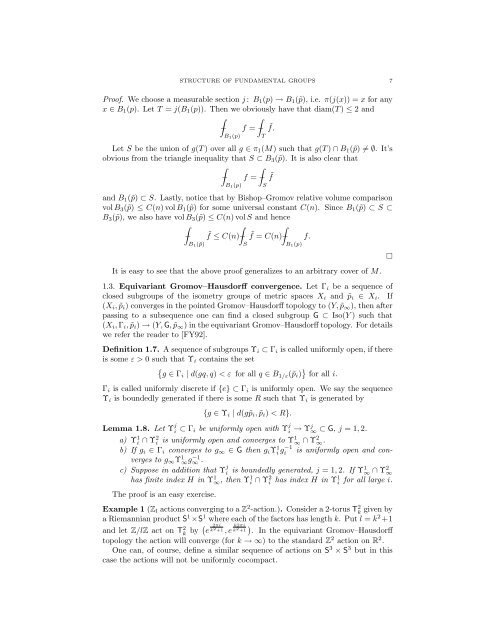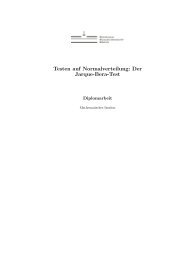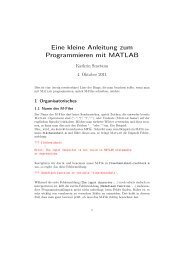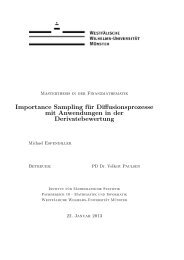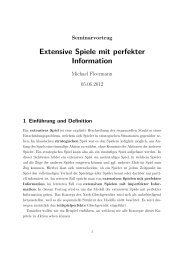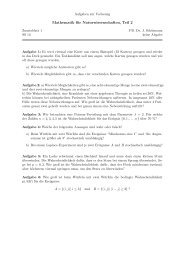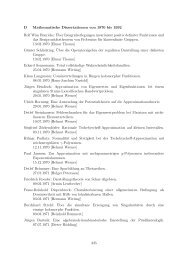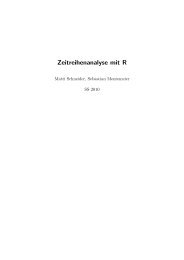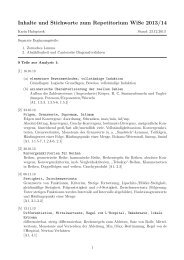Margulis Lemma
Margulis Lemma
Margulis Lemma
Create successful ePaper yourself
Turn your PDF publications into a flip-book with our unique Google optimized e-Paper software.
STRUCTURE OF FUNDAMENTAL GROUPS 7<br />
Proof. We choose a measurable section j : B 1 (p) → B 1 (˜p), i.e. π(j(x)) = x for any<br />
x ∈ B 1 (p). Let T = j(B 1 (p)). Then we obviously have that diam(T ) ≤ 2 and<br />
∫ ∫<br />
− f = − ˜f.<br />
B 1(p)<br />
Let S be the union of g(T ) over all g ∈ π 1 (M) such that g(T ) ∩ B 1 (˜p) ≠ ∅. It’s<br />
obvious from the triangle inequality that S ⊂ B 3 (˜p). It is also clear that<br />
∫ ∫<br />
− f = − ˜f<br />
B 1(p)<br />
and B 1 (˜p) ⊂ S. Lastly, notice that by Bishop–Gromov relative volume comparison<br />
vol B 3 (˜p) ≤ C(n) vol B 1 (˜p) for some universal constant C(n). Since B 1 (˜p) ⊂ S ⊂<br />
B 3 (˜p), we also have vol B 3 (˜p) ≤ C(n) vol S and hence<br />
∫<br />
∫ ∫<br />
− ˜f ≤ C(n)− ˜f = C(n)− f.<br />
B 1(˜p)<br />
S<br />
T<br />
S<br />
B 1(p)<br />
It is easy to see that the above proof generalizes to an arbitrary cover of M.<br />
1.3. Equivariant Gromov–Hausdorff convergence. Let Γ i be a sequence of<br />
closed subgroups of the isometry groups of metric spaces X i and ˜p i ∈ X i . If<br />
(X i , ˜p i ) converges in the pointed Gromov–Hausdorff topology to (Y, ˜p ∞ ), then after<br />
passing to a subsequence one can find a closed subgroup G ⊂ Iso(Y ) such that<br />
(X i , Γ i , ˜p i ) → (Y, G, ˜p ∞ ) in the equivariant Gromov–Hausdorff topology. For details<br />
we refer the reader to [FY92].<br />
Definition 1.7. A sequence of subgroups Υ i ⊂ Γ i is called uniformly open, if there<br />
is some ε > 0 such that Υ i contains the set<br />
{<br />
g ∈ Γi | d(gq, q) < ε for all q ∈ B 1/ε (˜p i ) } for all i.<br />
Γ i is called uniformly discrete if {e} ⊂ Γ i is uniformly open. We say the sequence<br />
Υ i is boundedly generated if there is some R such that Υ i is generated by<br />
{g ∈ Υ i | d(g˜p i , ˜p i ) < R}.<br />
<strong>Lemma</strong> 1.8. Let Υ j i ⊂ Γ i be uniformly open with Υ j i → Υj ∞ ⊂ G, j = 1, 2.<br />
a) Υ 1 i ∩ Υ2 i is uniformly open and converges to Υ1 ∞ ∩ Υ 2 ∞.<br />
b) If g i ∈ Γ i converges to g ∞ ∈ G then g i Υ 1 i g−1 i is uniformly open and converges<br />
to g ∞ Υ 1 ∞g∞ −1 .<br />
c) Suppose in addition that Υ j i is boundedly generated, j = 1, 2. If Υ1 ∞ ∩ Υ 2 ∞<br />
has finite index H in Υ 1 ∞, then Υ 1 i ∩ Υ2 i has index H in Υ1 i for all large i.<br />
The proof is an easy exercise.<br />
Example 1 (Z l actions converging to a Z 2 -action.). Consider a 2-torus T 2 k<br />
given by<br />
a Riemannian product S 1 ×S 1 where each of the factors has length k. Put l = k 2 +1<br />
and let Z/lZ act on T 2 k by ( e 2πi<br />
k 2 k2πi )<br />
+1 , e k 2 +1 . In the equivariant Gromov–Hausdorff<br />
topology the action will converge (for k → ∞) to the standard Z 2 action on R 2 .<br />
One can, of course, define a similar sequence of actions on S 3 × S 3 but in this<br />
case the actions will not be uniformly cocompact.<br />
□


